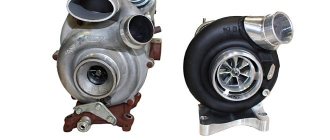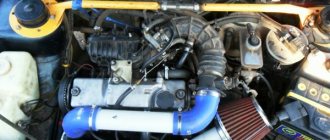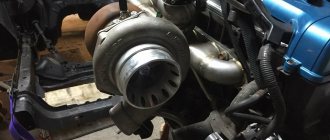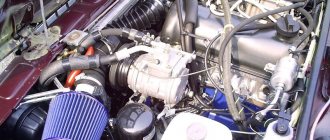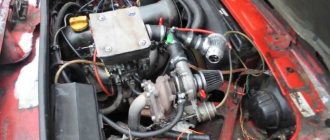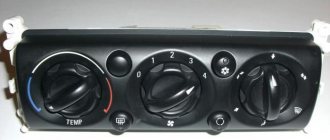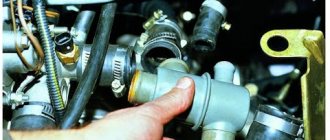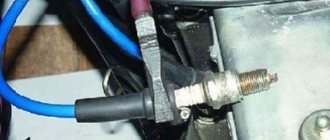The power produced by an internal combustion engine depends on the amount of fuel and air entering the engine. Engine power can be increased by increasing the volume of these components. The constant race of engineers to increase the power of internal combustion engines led to the emergence of turbochargers. This solution turned out to be the most effective on both gasoline and diesel engines. It becomes quite obvious that the final power of the internal combustion engine is proportional to the amount of the air-fuel mixture that enters the engine cylinders.
It is natural that an engine with a larger displacement is able to pass more air and thereby produce more power compared to an engine of a smaller displacement.
If we are faced with the task of achieving from a small-volume internal combustion engine the same power that larger-volume engines demonstrate, then it is necessary to force as much air as possible into the cylinders of such an engine. That is, increasing the fuel supply is meaningless if the supply of air necessary for its combustion does not increase. Therefore, the air entering the engine cylinders has to be compressed. The forced air supply system can operate using exhaust gas energy or using a mechanical drive. A turbocharger or turbocharger
is a device designed to force air into an engine using the energy of exhaust gases. The main parts of a turbocharger are a turbine and a centrifugal pump, which are connected by a common rigid axis. These elements rotate at a speed of about 100,000 rpm, driving the compressor.
About the history of the invention and implementation of turbocharging
So, the idea of “putting into action” the energy of exhaust gases appeared soon after the invention and successful experiments in the use of internal combustion engines. German engineers and pioneers of automobile and tractor construction, led by Diesel and Daimler, conducted the first experiments in increasing engine power and reducing fuel consumption by pumping compressed air from exhausts.
Gottdieb Daimler produced cars like this, and was already thinking about introducing a turbocharging system
But the first to build the first efficient turbocharger was not them, but another engineer, Alfred Büchi. In 1911, he received a patent for his invention. The first turbines were such that it was possible and advisable to use them only on large engines (for example, ships).
Next, turbochargers began to be used in the aviation industry. Beginning in the 1930s, the United States regularly launched military aircraft (both fighters and bombers) with gasoline engines equipped with turbochargers. And the first truck in history with a turbocharged diesel engine was made in 1938.
In the 60s, the General Motors Corporation produced the first Chevrolet and Oldsmobile passenger cars with turbocharged gasoline carburetor engines. The reliability of those turbines was poor, and they quickly disappeared from the market.
1962 Oldsmobile Jetfire - the first turbocharged production car
The fashion for turbocharged engines returned at the turn of the 70s/80s, when turbocharging began to be widely used in the creation of sports and racing cars. The “turbo” prefix became extremely popular and turned into a kind of label. In Hollywood films of those years, superheroes pressed the “magic” turbo buttons on the panels of their supercars, and the car sped off into the distance. In reality, the turbochargers of those years noticeably “slowed down,” producing a significant delay in response. And, by the way, not only did they not contribute to fuel economy, but on the contrary, they increased its consumption.
A worker of Soviet fields - the K-701 "Kirovets" tractor with turbocharging
The first truly successful attempts to introduce turbocharging into the production of mass-produced automobile engines were carried out in the early 80s by SAAB and Mercedes. Other global engineering companies were quick to take advantage of this advanced experience.
In the Soviet Union, the development and introduction of turbocharged engines into the “series” was associated, first of all, with the development of the production of heavy industrial and agricultural tractors - “ChTZ”, “Kirovets”; BelAZ super dump trucks, etc. powerful technology.
Why did turbines eventually become widespread on diesel rather than gasoline engines? Because diesel engines have a much higher degree of air compression, and their exhaust gases have a lower temperature. Accordingly, the requirements for the heat resistance of the turbine are much lower, and its cost and efficiency of use are much higher.
Turbocharged engine: advantages and disadvantages
The popularity of turbo engines is due to their advantages over conventional ones, which include:
- increasing power up to 30% and reducing fuel consumption (a turbo engine will consume less fuel than an internal combustion engine of similar power, but without a turbine);
- reducing environmental pollution;
- better ratio of unit weight to developed power;
- quieter operation of the mechanism;
- opportunities to optimize other engine parameters.
However, there are also some disadvantages:
- demands on the quality of oil and gasoline, which ultimately increases the cost of operating a car;
- complex repairs that require the use of special equipment, which is unlikely to be performed on your own. Often the turbine turns out to be completely unsuitable for repair, and its complete replacement significantly impacts the car owner’s wallet.
Turbocharging system design
The turbocharging system consists of two parts: a turbine and a turbocharger. The turbine is used to convert the energy of exhaust gases, and the compressor is used directly to supply repeatedly compressed atmospheric air into the working cavities of the cylinders. The main parts of the system are two blade wheels, a turbine and a compressor (the so-called “impellers”). A turbocharger is a high-tech air pump driven by the rotation of a turbine rotor. Its only task is to pump compressed air into the cylinders under pressure.
The more air enters the combustion chamber, the more diesel fuel the diesel engine can burn in a specific unit of time. The result is a significant increase in engine power, without the need to increase the volume of its cylinders.
Components of the turbocharging device:
- compressor housing;
- compressor wheel;
- rotor shaft, or axis;
- turbine housing;
- turbine wheel;
- bearing housing.
The basis of the turbocharging system is a rotor mounted on a special axis and enclosed in a special heat-resistant housing. The continuous contact of all components of the turbine with extremely hot gases determines the need to create both the rotor and the turbine housing from special heat-resistant metal alloys.
The impeller and turbine axis rotate at very high speeds and in opposite directions. This ensures that one element is pressed tightly against another. The flow of exhaust gases first penetrates the exhaust manifold, from where it enters a special channel located in the turbocharger housing. The shape of its body resembles the shell of a snail. After passing through this “snail”, the exhaust gases are accelerated and supplied to the rotor. This ensures forward rotation of the turbine.
The turbocharger axis is mounted on special plain bearings; Lubrication is carried out by supplying oil from the engine compartment lubrication system. O-rings and gaskets prevent oil leaks, as well as air and exhaust gases from blowing through and mixing. Of course, it is not possible to completely eliminate exhaust from entering the compressed atmospheric air, but this is not really necessary...
How does a diesel engine turbine work?
The power of any engine and its performance depend on a number of reasons. Namely: on the working volume of the cylinders, on the amount of supplied air-fuel mixture, on the efficiency of its combustion, as well as on the energy part of the fuel. Engine power increases in proportion to the increase in the amount of fuel burned in it over a certain unit of time. But to accelerate fuel combustion, it is necessary to increase the supply of compressed air in the working cavities of the engine.
That is, the more fuel is burned per unit of time, the greater the amount of air will need to be “shoved” into the motor (the not very beautiful word “shove” here, however, fits very well, since the motor itself cannot cope with the intake of excess amounts of compressed air , and zero-resistance filters will not help him with this).
This, we repeat, is the main purpose of turbocharging - to increase the supply of air-fuel mixture to the combustion chambers. This is ensured by the injection of compressed air into the cylinders, which occurs under constant pressure. It occurs as a result of converting the energy of exhaust gases, in other words, from waste and lost - into useful. To do this, before the exhaust gases must be discharged into the exhaust pipe, and then into the atmosphere, their flow is directed through the turbocharger system.
This process ensures that the turbine wheel (“impeller”), equipped with special blades, spins up to 100-150 thousand revolutions per minute. The compressor blades, which pump compressed air into the engine cylinders, are also attached to the same shaft with the impeller. The force obtained from converting the energy of the exhaust gases is used to significantly increase air pressure. Thanks to this, it becomes possible to inject a much larger amount of fuel into the working cavities of the cylinders in a fixed time. This gives a significant increase in both power and efficiency of the diesel engine.
Diesel turbine cross-section
Simply put, the turbo system contains two bladed “impellers” mounted on one common shaft. But they are located in separate chambers, hermetically separated from each other. One of the impellers is forced to rotate from the engine exhaust gases constantly flowing onto its blades. Since the second impeller is rigidly connected to it, it also begins to rotate, capturing atmospheric air and supplying it in compressed form to the engine cylinders.
Air blower diagnostics
How to determine without special instruments that the turbocharger is broken? Firstly, this is evidenced by a drop in engine power. At the same time, dense white smoke pours out of the muffler, and lubricant consumption often increases to several liters per 100 km. This means that the supercharger must be immediately repaired or purchased a new one - sometimes replacing worn bearings and an o-ring does not give a positive result.
Secondly, situations often arise when there is no white smoke “screen” as such. It’s just that the engine can’t reach its required power, and no warning light on the instrument panel lights up. Owners of turbocharged cars have only one solution - an urgent visit to a car service center. It’s easier for owners of turbodiesels: a problem with the air blower is eloquently evidenced by black smoke at idle. Moreover, it is far from a fact that the turbo system has hopelessly failed - it may simply be worn out and completely repairable.
| Tweet |
Necessary additions to the turbocharging system: valves, intercooler
It took engineers decades to create a truly efficient turbocharger. After all, it’s only in theory that everything looks smooth: by converting the energy of exhaust gases, you can “recover” the lost percentage of efficiency and significantly increase engine power (for example, from one hundred to one hundred and sixty horsepower). But for some reason this did not work out in practice.
In addition, when you pressed the accelerator sharply, you had to wait for the engine speed to increase. It happened only after a certain pause. The increase in exhaust gas pressure, the spin-up of the turbine and the injection of compressed air did not occur immediately, but gradually. This phenomenon, called “turbolag” (“turbo lag”), could not be tamed. And it was possible to cope with it by using two additional valves: one to bypass excess air into the compressor through a pipeline from the engine manifold. And the other valve is for exhaust gases. And in general, modern turbines with variable blade geometry, even in their shape, are already significantly different from the classical turbines of the second half of the twentieth century.
Bosch diesel turbocharger
Another problem that had to be addressed during the development of diesel turbine technology was excessive detonation. This detonation occurred due to a sharp increase in temperature in the working cavities of the cylinders when additional masses of compressed air were pumped into them, especially at the final stage of the stroke. The charge air intercooler (intercooler) is designed to solve this problem in the system.
An intercooler is nothing more than a radiator for cooling the charge air. In addition to reducing detonation, it also reduces the air temperature in order not to reduce its density. And this is inevitable during the heating process from compression, and from this the efficiency of the entire system drops significantly.
In addition, a modern engine turbocharging system cannot do without:
- control valve (wastegate). It serves to maintain optimal pressure in the system, and to release it, if necessary, into the exhaust pipe;
- bypass valve. Its purpose is to divert charge air back into the intake pipes up to the turbine, if it is necessary to reduce power and the throttle valve closes;
- and/or “blow-off-valve”. Which bleeds charge air into the atmosphere if the throttle is closed and there is no mass air flow sensor;
- exhaust manifold compatible with turbocharger;
- sealed pipes: air pipes for supplying air to the intake, and oil pipes for cooling and lubrication of the turbocharger.
Where is it used?
Basically, such a unit can be found on modern cars. But this supercharger is not used on all internal combustion engines. A limiting factor in the use of turbines on gasoline engines is the high degree of detonation. It is associated with an increase in the rotation speed of the internal combustion engine and the enormous temperature of the exhaust gases (up to a thousand degrees). Because of this, a diesel engine turbine is often used. The operating principle of such an internal combustion engine is somewhat different. There is a lower risk of detonation, and the temperature of the gases does not exceed 600 degrees. Compressors are especially common in commercial vehicles. It is impossible to imagine a modern bus or long-haul tractor not equipped with such a turbine. If we talk about brands, the turbine is installed on the following cars:
- "Volkswagen".
- "Mercedes".
- "Volvo".
- "Mazda".
- "Audi".
- Renault.
- "Toyota".
There are other areas where a similar element is used. For example, these are power plants and internal combustion engines of ships. But here a steam turbine is already used, the operating principle of which we will consider a little later.
Application of turbocharging in global mechanical engineering
It’s the twenty-first century, and no one is anymore chasing the name of their car with the “turbo” prefix, which was fashionable in the 20th century. Nobody believes in the “magical power of a turbine” to dramatically accelerate a car anymore. The meaning of the use and efficiency of the turbocharging system is still not the point.
This is a “snail”!
Of course, turbocharging is most effective when used on tractor and heavy truck engines. It allows you to add power and torque without excessive fuel consumption, which is very important for the economic performance of the equipment. That's where it is used. Turbo systems have also found wide application on diesel locomotive and marine diesel engines. And these are the most powerful man-made turbines for a diesel engine.

